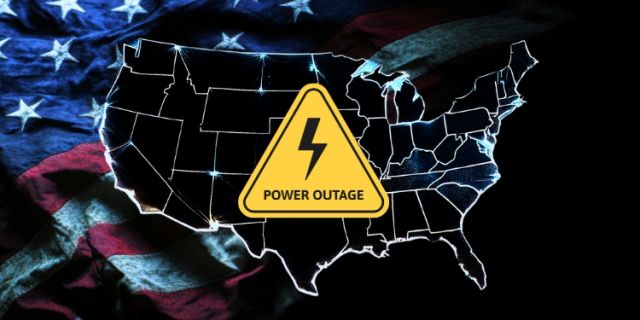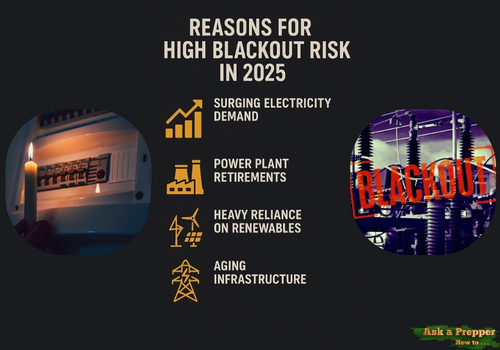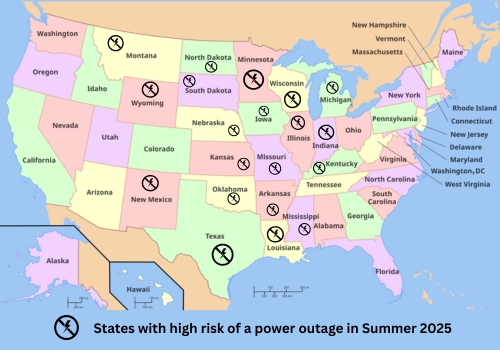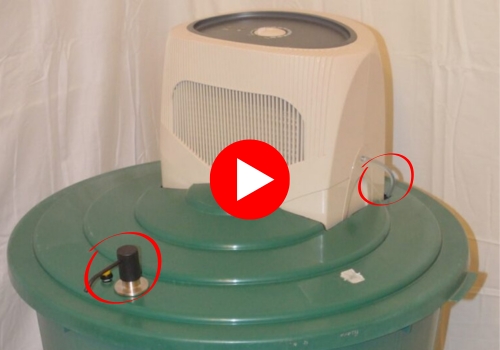These 20 States Will Go Dark This Summer. Do You Live in One of Them?

Article initially published on AskAPrepper.com
As summer temperatures climb across the U.S., so does the strain on our power grid. Millions rely on air conditioning, refrigeration, and medical devices to stay safe during extreme heat. But what happens if the grid can’t keep up? According to NERC (North American Electric Reliability Corporation), more states than ever face a real risk of blackouts during summer 2025. While we all hope for a smooth summer, the reality is that our electrical infrastructure is aging and more vulnerable to extreme weather than many people realize. For those of you who like to stay ahead of the curve – whether you’re a full-fledged prepper or just someone who values self-reliance – understanding these risks is the first step to staying safe and comfortable if the power goes out.
What is NERC And How Trustworthy are They?
NERC is a nonprofit group responsible for keeping the bulk power grid across North America running smoothly. At least in theory. Like any institution tied to government oversight, NERC isn’t perfect. So, when you ask, “Should I trust NERC?” the only honest answer is: it depends.
That said, to give credit where it’s due, they’ve managed to sound the alarm on big problems before they hit. Over the years, they’ve pointed out vulnerabilities that ended up leading to major blackouts. One clear example: back in February 2021, Texas was hammered by a brutal winter storm that left millions freezing in the dark. NERC had actually flagged this risk in previous reliability reports, warning about cold-weather weaknesses in the grid.
So, while they have their flaws and you should always take any official report with a grain of salt, it’s still worth paying attention when they tell you the grid might not hold up. Because when they do get it right, it’s usually a sign you should start double-checking your own preps.
What Does NERC’s 2025 Summer Reliability Assessment Say?
While the U.S. grid has faced summer challenges before, 2025 stands out for several reasons. According to the NERC’s 2025 Summer Reliability Assessment, the nation is heading into the hottest months with a unique combination of stressors.
Electricity demand has climbed sharply. NERC projects a 10 GW (gigawatts) increase in peak demand compared to last summer. That’s more than double the increase seen in 2024. This surge is fueled by growing data center activity (especially in states like Texas and Illinois), electrification trends (more electric vehicles, more electric heating and cooling), and industrial expansion.
At the same time, many older, dispatchable power plants, especially coal and natural gas, have been retired or placed on standby. Just this year, over 7.4 GW of reliable generation capacity has been retired or sidelined, creating tighter supply margins across multiple regions.
Adding to the strain is a heavier reliance on renewable energy sources, such as wind and solar. While wind and solar are essential for a cleaner future, they depend heavily on weather. During heatwaves, when winds calm and the sun sets just as air conditioning demand peaks, renewable output can drop off, leaving the grid scrambling…
Finally, aging infrastructure and global supply chain constraints have made it difficult to replace or repair critical equipment quickly. Distribution transformers, for example, are in short supply nationwide, and labor shortages persist in many utility service areas.

In short, while the grid is designed to handle expected peaks, it has less margin to absorb surprises. For those living in higher-risk states, this summer may bring more than just higher electric bills. It could mean real interruptions to daily life if the grid falters.
States Most at Risk of Blackouts in 2025
Based on the latest summer reliability report from NERC and regional grid operators, about 20 states across the U.S. are facing the highest risk of power shortages and rolling blackouts this summer. If you live in one of these states, it’s time to take a hard look at your backup plans, before the lights go out.
Most of these states fall under the Midcontinent Independent System Operator (MISO), the Southwest Power Pool (SPP), and large parts of Texas covered by ERCOT.
Here’s the list of states most at risk:
- Arkansas
- Illinois
- Indiana
- Iowa
- Kentucky
- Louisiana
- Michigan
- Minnesota
- Mississippi
- Missouri
- Montana
- North Dakota
- South Dakota
- Wisconsin
- Texas
- Kansas
- Nebraska
- New Mexico
- Oklahoma
- Wyoming
What You Need to Know
In the Midwest, states like Illinois, Indiana, and Minnesota are in the danger zone thanks to a fragile energy mix. Many coal and natural gas plants have been retired, leaving these areas heavily reliant on wind and solar. But when the wind stops blowing and the sun hides, the grid struggles.
The Southwest Power Pool states, including Kansas, Nebraska, and Oklahoma, aren’t in much better shape. These regions face soaring summer demand paired with unpredictable wind generation. When a heat wave hits and turbines sit idle, entire communities can go dark in hours.

A Warning for Preppers Living in Other States
The “20 states at risk” figure isn’t from a single official list. It’s a combined snapshot from two major regional grids: MISO and SPP. NERC doesn’t spell out exactly 20 states on a red flag list. This combined number helps us see where the most strain is, but it’s not a perfect count.
 Why does this matter? Because the grid is a complex web, and risks don’t respect state lines perfectly. Some states show up on one list but not the other. By combining them, we get a clearer picture. But it also means the number “20” is more of a practical summary than a strict official count.
Why does this matter? Because the grid is a complex web, and risks don’t respect state lines perfectly. Some states show up on one list but not the other. By combining them, we get a clearer picture. But it also means the number “20” is more of a practical summary than a strict official count.
Therefore, even if you don’t see your state on this high-risk list, don’t let your guard down. All it takes is one intense heat wave, flash floods (see Texas) or an unexpected plant failure to send any grid spiraling. Just because your area isn’t marked bright red on a map today doesn’t mean you’re safe tomorrow.
This is why so many experienced preppers insist on staying ahead of the curve. When the grid buckles, it’s not just about comfort. It’s about keeping your family safe, your food from spoiling, and your home secure when everyone else is panicking.
Recent Outages Confirm the Threat of Blackouts 2025
We’ve already seen plenty of blackouts hit in summer 2025, proving just how shaky and overworked our power grid really is. On June 18, severe storms and tornadoes ripped through Missouri, Illinois, Indiana, and Ohio, leaving nearly 1.2 million people powerless. Jacksonville, Illinois, took a hard blow. Over 11,000 folks were left in the dark overnight, with no clue when the lights would come back.
And then there’s Texas – a prepper’s wake-up call. The grid, run by ERCOT, has been a mess for years, and 2025’s proving it again. February’s cold snap left thousands in the dark, but July’s floods were a gut punch. On July 4, Central Texas got slammed. Kerr County alone saw over 2,700 homes lose power when Tropical Storm Barry’s 5–11 inches of rain tore through, snapping power lines and flooding roads. Crews couldn’t even reach some spots, leaving folks without electricity for days in the heat.
Also, as of July 10, outages are still ongoing in places like North Carolina (more than 10,000 customers affected), Virginia (about 10,000), California (6,800), Pennsylvania (5,700), and Ohio (5,200). These numbers can shift up or down, depending on how quickly problems get fixed and whether new grid failures pop up.
All of these aren’t just freak incidents. They’re loud, flashing warnings that our aging grid is buckling under the weight of extreme weather and skyrocketing demand. If you’re paying attention, you know these aren’t problems you can ignore and hope will fix themselves. You either prepare now, or risk being left in the dark when it matters most.
What Can You Do to Prepare?
When it comes to blackouts, waiting until the lights go out is the worst possible plan. Real preparation means acting early, so you aren’t scrambling at the last second. Also, it’s important to keep in mind that you don’t know for how long the power will be out. Best case: hours. Worst case: weeks. Here’s a closer look at how you can stay ahead of the next grid failure.
Stay Informed
Knowledge is your first line of defense. Sign up for local power outage alerts from your utility company or local emergency management agency. Check updates from your regional grid operator regularly. You can also monitor real-time outage maps to see problems developing in your area before they hit your neighborhood. Staying aware gives you valuable time to charge devices, fill water containers, and get last-minute supplies before everyone rushes to the store.
Stock Up on Basic Supplies
When the power goes out, the last place you want to be is stuck in a crowded store fighting over the last gallon of water. Keep at least a two-week supply of non-perishable and long-lasting food, medications, and hygiene items on hand. Think through what you’d need if you couldn’t leave home for a while: candles or lanterns, manual can openers, extra fuel, and even entertainment like books or cards to keep morale up.
The Special Case of Water
There’s also the special case of water. In the U.S., the public water supply is largely tied to the power grid. That means in many areas, if the power goes down, so does your access to water, or at the very least, your access to (relative) safe, filtered water.
Picture this: a brutal heatwave, no way to cool your home, and no running water… God forbid.
So, what can you do? The answer is simple: build up a water stockpile or, even better, break your dependence on the grid altogether. Here are two solid options I highly recommend:
How does generating 50 gallons of clean water per day completely off-grid sound? If it sounds good to you, check out this backpack-sized water generator. It’s used by military forces around the world, even in harsh desert conditions. It’s affordable, easy to set up, and incredibly efficient. Oh, and it doesn’t need anything except… thin air!
If you’re looking for long-term water independence, you should also take a serious look at The Water Freedom System. This system is also trusted by militaries in the U.S., Israel, India, and the UK. It’s definitely worth a shot. Check it out here.
Reduce Your Energy Use
You can help prevent a blackout, and protect your own home, by lowering your usage during peak hours (usually in the afternoon and early evening). Run big appliances like dishwashers and washing machines overnight, set your AC a few degrees higher, and turn off lights or electronics you don’t need. Not only does this help the grid, but it may also save you money on your bill.
Another smart approach is to reduce your dependence on the grid as much as possible. And you can do this in more ways than just buying a backup generator. For example, you can take a page out of the Amish playbook. Instead of relying on electric appliances, you can swap out your most essential tools and household systems for air-powered tools that keep you self-sufficient even when the grid is down.
Sure, this solution might sound a bit complex at first, but it’s surprisingly cheap and easy to put into practice. Even if you’re not ready to completely give up modern comforts, it’s worth learning these methods so you’re prepared if a major power crisis hits.
Here are a few examples you might want to consider:
- Amish fridge that doesn’t need electricity
- DIY Off-Grid Water Filter
- Amish AC unit that cools your house without electricity
Invest in Backup Power
A reliable backup power source can be a true lifesaver. Depending on your budget and needs, this could be a portable generator, a whole-house standby generator, or even solar panels with battery storage. At the very least, consider smaller backup batteries for essential electronics and medical devices. Make sure to test your equipment ahead of time. A generator that won’t start during an emergency is about as useful as a rock.
Related: Emergency Power Supply: Backup When the Grid Goes Dark
Protect Your Electronics
Power outages often come with voltage spikes when the grid flickers back on. These surges can fry your electronics in an instant. Use surge protectors for important appliances and devices, and consider uninterruptible power supplies (UPS) for computers and sensitive medical equipment. It’s a relatively inexpensive way to save thousands of dollars and avoid losing valuable data or equipment.
Final Thoughts
The warnings about Blackouts 2025 across these states are real and backed by data. The severity depends on weather and grid stress, but recent outages prove these aren’t just hypothetical scenarios.
This isn’t about panic, but about practical preparedness. Taking steps now to protect your family and your home means when the next heatwave or storm hits, you won’t be caught off guard. After all, prepping is all about peace of mind.
Anyone can join.
Anyone can contribute.
Anyone can become informed about their world.
"United We Stand" Click Here To Create Your Personal Citizen Journalist Account Today, Be Sure To Invite Your Friends.
Before It’s News® is a community of individuals who report on what’s going on around them, from all around the world. Anyone can join. Anyone can contribute. Anyone can become informed about their world. "United We Stand" Click Here To Create Your Personal Citizen Journalist Account Today, Be Sure To Invite Your Friends.
LION'S MANE PRODUCT
Try Our Lion’s Mane WHOLE MIND Nootropic Blend 60 Capsules
Mushrooms are having a moment. One fabulous fungus in particular, lion’s mane, may help improve memory, depression and anxiety symptoms. They are also an excellent source of nutrients that show promise as a therapy for dementia, and other neurodegenerative diseases. If you’re living with anxiety or depression, you may be curious about all the therapy options out there — including the natural ones.Our Lion’s Mane WHOLE MIND Nootropic Blend has been formulated to utilize the potency of Lion’s mane but also include the benefits of four other Highly Beneficial Mushrooms. Synergistically, they work together to Build your health through improving cognitive function and immunity regardless of your age. Our Nootropic not only improves your Cognitive Function and Activates your Immune System, but it benefits growth of Essential Gut Flora, further enhancing your Vitality.
Our Formula includes: Lion’s Mane Mushrooms which Increase Brain Power through nerve growth, lessen anxiety, reduce depression, and improve concentration. Its an excellent adaptogen, promotes sleep and improves immunity. Shiitake Mushrooms which Fight cancer cells and infectious disease, boost the immune system, promotes brain function, and serves as a source of B vitamins. Maitake Mushrooms which regulate blood sugar levels of diabetics, reduce hypertension and boosts the immune system. Reishi Mushrooms which Fight inflammation, liver disease, fatigue, tumor growth and cancer. They Improve skin disorders and soothes digestive problems, stomach ulcers and leaky gut syndrome. Chaga Mushrooms which have anti-aging effects, boost immune function, improve stamina and athletic performance, even act as a natural aphrodisiac, fighting diabetes and improving liver function. Try Our Lion’s Mane WHOLE MIND Nootropic Blend 60 Capsules Today. Be 100% Satisfied or Receive a Full Money Back Guarantee. Order Yours Today by Following This Link.









EPSTEIN FILES WOULD CAUSE PUBLIC EXPOSURE WHICH TRUMP AND THE DS IS BLOCKING. THEREFORE NO MAJOR ARRESTS. TRUMP PURPOSELY NOT ALLOWING PEDOPHILIA ON MSM BECAUSE THAT WOULD EXPOSE HOW CORRUPT THE GOVERNMENT IS AND BRING DOWN THE DEEP STATE. TRUMP DOES EVERYTHING TO PREVENT PUBLIC EXPOSURE.NO MAJOR ARRESTS SAYS IT ALL!Some of the WHs are blaming all the flooding (1200 floods worldwide) on AI, but I wonder if it is just more disinfo since Trump refused to remove the facility at Alaska according to WH generals until the latest flooding forced his hand. White Hats See More Signs POTUS Has Been Replaced or is Drugged by Deep State: https://realrawnews.com/2025/07/white-hats-see-more-signs-potus-has-been-replaced-or-is-drugged-by-deep-state/ The US military appears dirty at the top. Supposedly they picked Trump. Makes sense they would pick someone that they could blackmail. I think the real Trump may have beentaken out around 2020-21 because they didn’t want him to dispute the election like he was doing at the time, but then made an abrupt reversal. This time span also fits in with the fact recognized by the WHs that the Galactic Federation of Worlds was infiltrated according to Michael Salla. Trump was also disputing the vaccine by presenting hydroxychloraquine and Ivermectin, 2 drugs big pharma negatively propagandized. After 2021 it was all “take the jab” and back off the election exposure. It was just before this time that 3 different sources said Trump was dead (Kim Goguen, the Scott Mckay Jaco trained remote viewer and the WH psychic, Utsava. By not disputing the election they slowed down disclosure and it sure worked. At the time the military claimed Trump won every state with 80% of the total vote. The fact that an obvious fake Trump can last so long as WH leader suggests the WHs are highly infiltrated.
SERPENTS ROADMAP TO ENSLAVING HUMANITY (EUGENICS, VAXXED, UN2030) – MUST SHARE! (BIN QUIT SUPPRESSING MY POSTS/VIEWS!)
/new-world-order/2025/07/serpents-roadmap-to-enslaving-humanity-eugenics-vaxxed-un2030-must-share-15444.html
4TH INDUSTRIAL REVOLUTION TRANSHUMANISM AGENDA: BUILDING AN ANDROGYNOUS / ANDROGYNE UTOPIA (BIN QUIT SUPPRESSING MY VIEWS & POSTS!)
/new-world-order/2025/07/4th-industrial-revolution-transhumanism-agenda-building-an-androgynous-androgyne-utopia-bin-quit-suppressing-my-views-posts-15446.html
RABBI GIVES PRESENTATION TO STUDENTS CLAIMING THEY ARE ALIENS FROM ANOTHER DIMENSION HERE TO CONQUER EARTH (BIN QUIT SUPPRESSING MY VIEWS/POSTS!)
/new-world-order/2025/07/rabbi-gives-presentation-to-students-claiming-they-are-aliens-from-another-dimension-here-to-conquer-earth-bin-quit-suppressing-my-viewsposts-15445.html